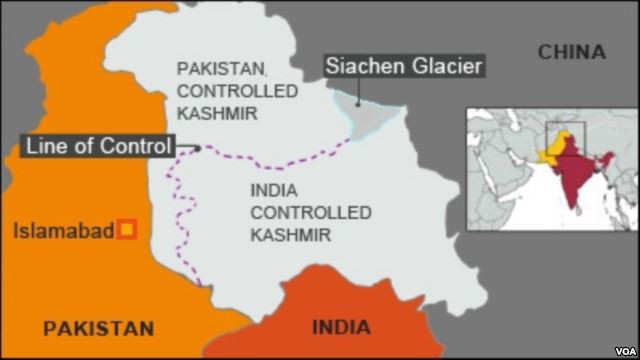Raji Gururaj, NALSAR 2018 has written this note that shall serve as an extremely comprehensive and well researched backgrounder on everything to do with the recent tensions between India and Pakistan at the Line of Control.
In the face of the allegations and counter-allegations of ceasefire violations along the LoC, this bone of contention between India and Pakistan needs a closer look.
In 1947, Britain divided its Indian Empire into Muslim Pakistan, and India, triggering one of the greatest and bloodiest migrations of modern history. The Maharaja of the princely state of Jammu and Kashmir decided to hand over key powers to India, in return for military aid and a promised referendum. Subsequently that year, India and Pakistan went to war over Kashmir, which ended with a U.N.-ordered ceasefire and resolution seeking a plebiscite for the people of Jammu and Kashmir to decide whether to become part of India or Pakistan. This resolution passed by the Security Council required among other things that Pakistan withdraw from the areas of Pakistan-administered Kashmir which it had captured in 1947, and also that the Indian Army withdraw and maintain a skeletal force to ensure proper functioning of the civil affairs of the state after satisfactory withdrawal of Pakistani tribesmen and forces.
In 1965, however, India and Pakistan fought their second war over Kashmir, which ended after a ceasefire declared by the UN. In 1972, Pakistani Prime Minister Zulfikar Ali Bhutto and Indian Prime Minister Indira Gandhi signed the Shimla agreement over principles meant to govern relations between the two countries on the Kashmir issue. This agreement laid down a Line of Control, that was to divide Kashmir into two regions, one under Indian control, and the other, under Pakistani control. The line, to this day, does not constitute a legally recognised international boundary, but exists as the de facto boundary. The part of the former princely state that is under Indian control is known as the State of Jammu and Kashmir. The two parts of the former princely state that are under Pakistani control are known as Gilgit–Baltistan and Azad Jammu and Kashmir (AJK). This is not to be confused with the Line of Actual Control, which divides Indian-controlled Kashmir from that which is occupied by China.
In 1987, the state elections in Kashmir were allegedly rigged in favour of Farooq Abdullah, leading to the rise of an armed insurgency movement, composed in part, by those who unfairly lost the elections. Pakistan allegedly supplied these groups with logistical support, arms, recruits and training. Such involvement of Pakistan’s paramilitary forces and the infiltration of Pakistani soldiers and Kashmiri militants into the Indian side of the LoC, coupled with the issue of control over the Siachen Glacier ultimately led to the Kargil War in 1999. By the end of the war, India had resumed control over its territories, previously infiltrated by Pakistan.
In July 2001 , a Summit between Pakistani leader General Pervez Musharraf and Vajpayee in Agra in India ended in failure and subsequently in December, Militants attacked the Indian parliament. India blamed Pakistan-based Kashmiri separatist groups Lashkar-e-Taiba (LeT) and Jaish-e-Mohammad. One million troops were mobilised on either side of the border; war was only averted months later in June 2002. Later in 2003, India and Pakistan agreed upon a formal ceasefire along the LoC, and peace processes were launched.
Although the insurgency today may not be so vigorously fought as it was in the 1990s, the scope for violence to re-surface is never far away. The peace process has been hampered time and again by border skirmishes, ceasefire violations, and more significantly, in the wake of Pakistani involvement in the Mumbai terror attacks that killed 166 people, and India’s hanging of the lone surviving perpetrator of these attacks.
This year has seen a spate of violations of the ceasefire declared in 2003, on both sides of the LoC, in a chain of aggression and retaliation.
January 2013 – India accuses Pakistan of “barbaric and inhuman” behaviour after two Indian soldiers are killed in a firefight in Kashmir and at least one of the bodies is mutilated. Peace talks stall and Indian Prime Minister Singh says there can be no “business as usual”.
February 2013 – India hangs a Kashmiri man for the 2001 attack on its parliament that New Delhi blamed on militants backed by Pakistan.
May 2013 – Nawaz Sharif returns to power in Pakistan vowing to improve relations with India and ease decades of mistrust.
July 2013 – Pakistan proposes dates for resuming talks at a senior bureaucrat level on disputed water and territorial issues, possibly in August and September. Indian officials say they are also considering a proposal by Islamabad for Sharif and Singh to meet in New York in September, on the sidelines of the U.N. General Assembly.
August 2013 – Defence Minister A.K. Antony says the number of infiltration attempts from the Pakistani side of Kashmir is double that reported in January-August 2012. There has also been an 80 percent increase in ceasefire violations over the same period.
These recent events are not only worrisome, but also have deep implications. India and Pakistan are both nuclear-empowered, developing economies. Kashmir has long stood as a bone of contention, and if these ceasefire violations are not regulated and mitigated at the earliest, the situation could well slide on a downhill, impairing peace processes and resulting in a war-like situation, and not to mention, the loss of hundreds of innocent lives on both sides of the LoC.
Further reading:
- http://www.bbc.co.uk/news/magazine-19168219
- http://www.un.org/en/peacekeeping/missions/unmogip/background.shtml
- http://idsa.in/node/11297/21088
- http://www.thehindu.com/opinion/lead/beware-the-dogs-of-war/article4313464.ece
- http://www.bbc.co.uk/news/world-south-asia-16069078
- http://www.bbc.co.uk/news/world-south-asia-11693674










thanks..:) it’s very helpful article for us,… to know subsequent …. events.
very informative:) Thanks 🙂
Its a very well-written and informative report. Thank you.
Thanks Raji 😀